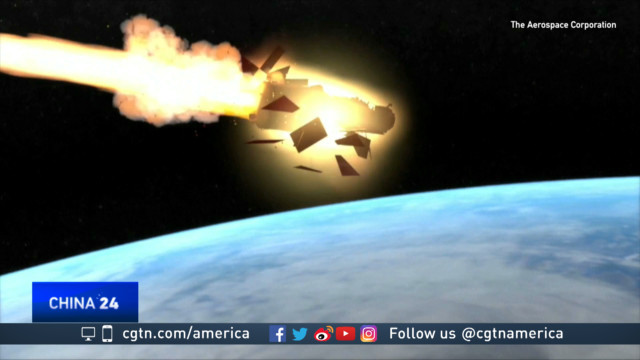Eyes will be on the sky this weekend across much of the globe as the Chinese space station Tiangong-1 comes hurtling back to Earth. The eight metric ton spacecraft has been in a slow death dive for the past two years. But figuring out when and where it will come down has been virtually impossible.
CGTN’s Hendrik Sybrandy reports.
“No concern about this, nope,” said Darren Osborne, Flight Director for the Laboratory for Atmospheric and Space Physics at the University of Colorado Boulder. “No worries.”
The size of a school bus, Tiangong-1 is on the verge of re-entering the atmosphere. China’s first space station was launched in 2011. After more than four years of service, which included a visit by China’s first female astronaut, contact with the spacecraft was lost in 2016.
“Which means they can’t talk to it, and they can’t necessarily figure out exactly where it’s at,” Osborne said.
Scientists do know it’s gradually been drifting back to Earth.
“There’s a little bit of atmosphere out there which causes drag on the spacecraft,” said Steve Lee, Space Scientist with the Denver Museum of Nature and Science. “It slows down a little bit so it’s constantly dropping altitude.”
But Lee said heat from the Sun, which increases that atmospheric pull, and uncertainty about the way the Tiangong-1 is tumbling have made pinpointing its exact location very difficult.
“Now it’s at the point where there’s no stopping it,” he said.
Experts now predict it will finally plummet to Earth on Sunday, with pieces of the spacecraft landing somewhere in a large belt encompassing Africa and large portions of the Americas and Asia.
“You know anytime you can actually see it, that’s a pretty neat thing to see,” Osborne said.
The question is will Tiangong-1’s re-entry even be visible? Parts of the U.S. Skylab space station did land in Australia in 1979.
The European Space Agency estimates 20 to 40 percent of each large space object typically makes it through the atmosphere but it also insists there’s zero reason to worry.
“My estimate is that the probability to be injured by one of these fragments is similar to the probability of being hit by lightning twice in the same year,” said Holger Krag with the European Space Agency.
But even that infinitesimal possibility has seemed to grab people’s attention.
“The natural tendency of the media coverage is to worry about the sky is falling, somebody could get hit with pieces of this,” Lee said.
Or not. The Tiangong-1 drama, such as it is, should be resolved by Monday.
 CGTN America
CGTN America

